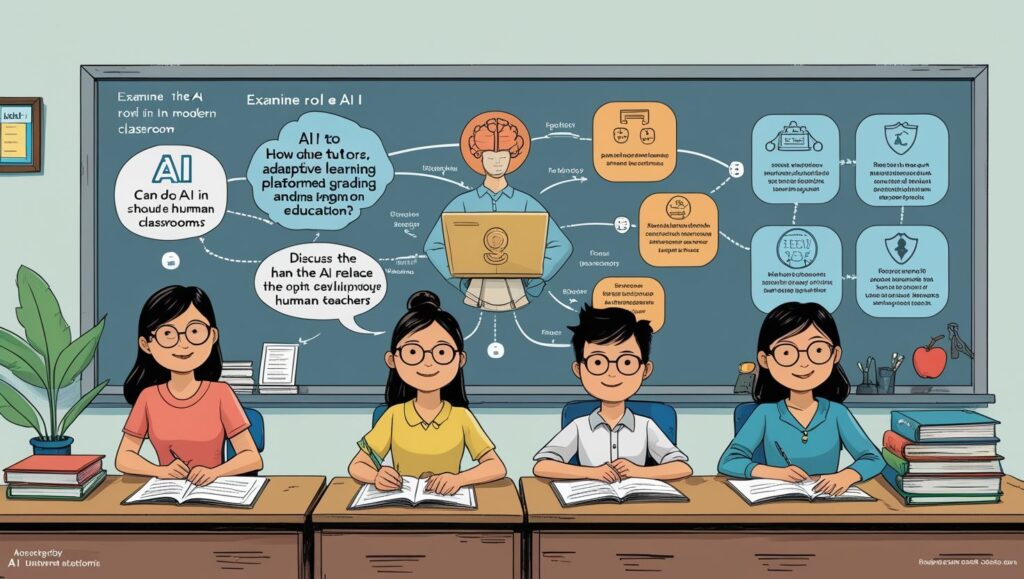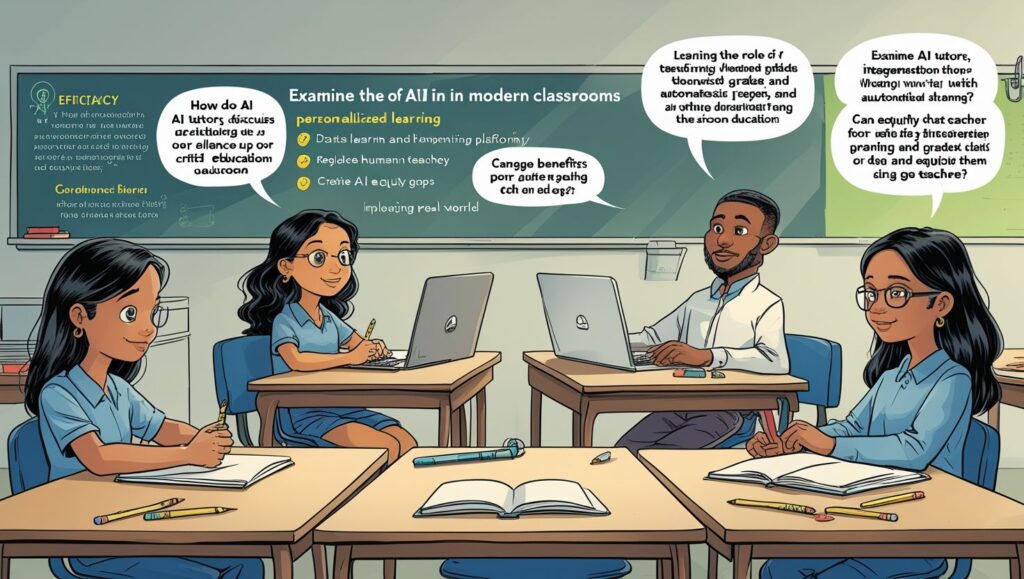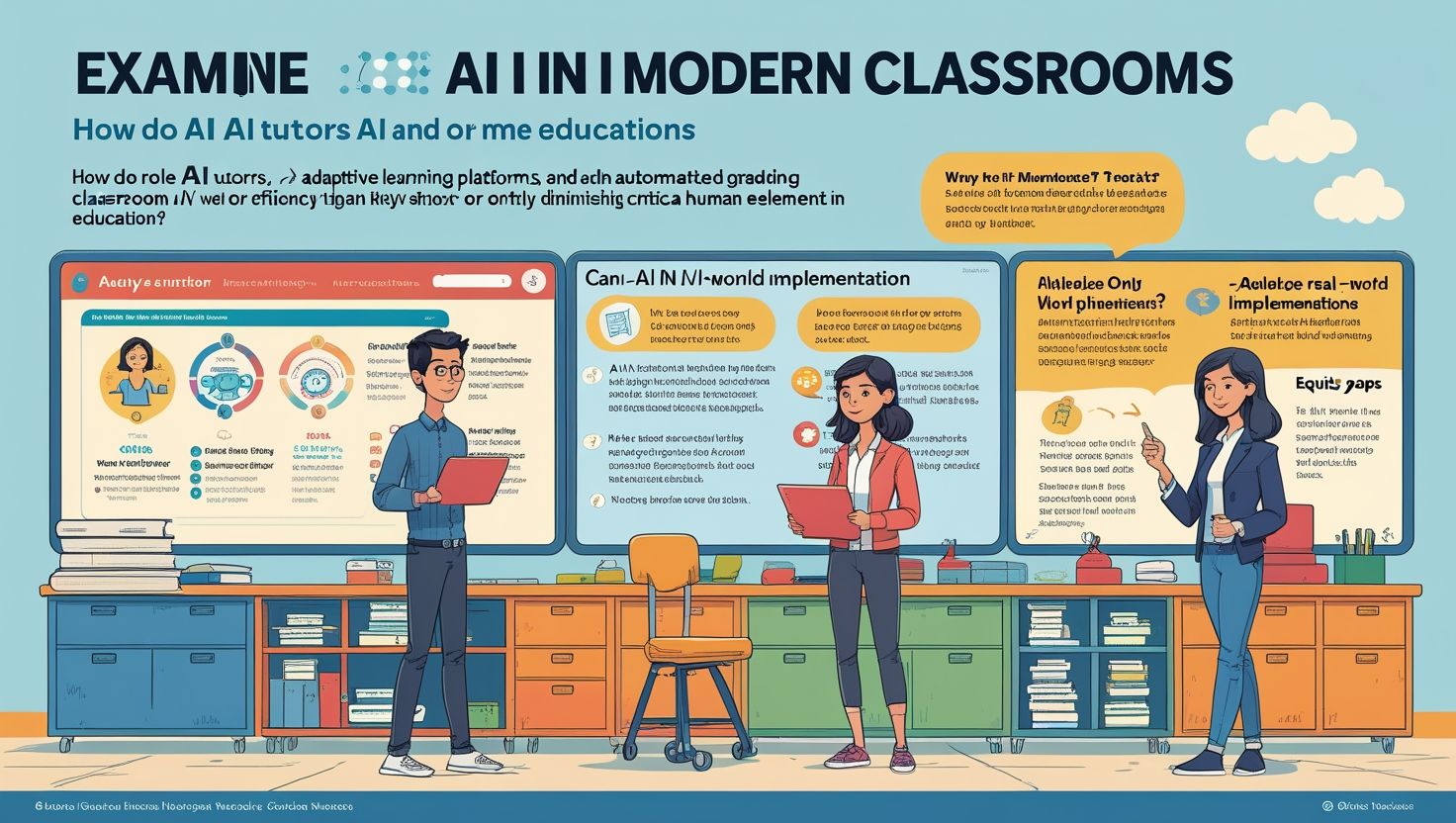1. Introduction
AI Teaching in the Classroom, Artificial Intelligence (AI) is reshaping the educational landscape by offering tools and methods that enhance both teaching and learning. In classrooms today, AI is no longer a futuristic concept but a practical solution that transforms how information is delivered, understood, and retained. AI applications include intelligent tutoring systems, automated grading, language translation, and learning analytics. These innovations allow educators to better understand student needs and adapt instruction accordingly.
Furthermore, AI enables personalized learning paths, which cater to individual student abilities and learning paces. The integration of AI into education promises improved outcomes by reducing the administrative load on teachers and allowing more time for direct interaction with students. As AI technologies continue to evolve, their potential impact on pedagogy, curriculum development, and classroom management grows. However, its effective implementation requires teacher training, infrastructure, and ethical consideration to avoid dependency or misuse. This article explores various facets of AI’s role in classroom teaching and its implications for the future of education.
2. Personalized Learning through AI
AI’s capacity to analyze large amounts of data in real-time makes personalized learning more achievable than ever before. With AI systems monitoring student performance, strengths, weaknesses, and learning patterns, educators can tailor instruction to meet individual needs. For example, AI-driven platforms like DreamBox or Knewton adjust lesson difficulty based on a learner’s response history, ensuring they are neither bored nor overwhelmed. These systems offer feedback instantly, allowing learners to correct mistakes and deepen understanding on the spot. Personalized learning fosters student engagement and motivation, as learners feel recognized and supported.
AI also provides adaptive assessments that fine-tune content delivery based on real-time student input. While traditional teaching follows a one-size-fits-all model, AI makes individualized instruction practical at scale. However, teachers play a crucial role in interpreting AI insights and offering the human touch that machines cannot replicate. Ultimately, AI empowers educators to focus more on mentorship, creativity, and emotional intelligence in the learning process.
3. AI-Powered Classroom Management
AI has introduced new tools for efficient classroom management. From facial recognition-based attendance systems to emotion-detecting cameras and automated behavior tracking, AI supports teachers in creating orderly, responsive learning environments. For instance, platforms like Classcraft gamify classroom behavior using AI algorithms that reward positive conduct and flag disruptions. AI chatbots can handle routine administrative tasks, such as answering FAQs, organizing schedules, or sending reminders.
Furthermore, AI-driven classroom assistants help in monitoring student activity on digital platforms, identifying potential distractions, and encouraging focus. These tools free up teacher time and reduce stress, enabling educators to concentrate on instruction and student engagement. However, integrating AI into classroom management raises concerns about privacy and surveillance, which must be addressed through clear policies and ethical guidelines. When used responsibly, AI can lead to a well-organized, inclusive, and adaptive classroom environment that benefits students and supports teacher efficiency.

4. Intelligent Tutoring Systems (ITS)
Intelligent Tutoring Systems (ITS) simulate human tutoring by offering individualized instruction and feedback. AI-driven platforms such as Carnegie Learning and Squirrel AI assess a learner’s current knowledge state and adapt the instructional content accordingly. These systems break down complex concepts into manageable pieces and adjust the pace to match the learner’s comprehension level. ITS can be particularly effective in subjects like mathematics, where students often require step-by-step guidance.
They also use natural language processing to interact with students conversationally, making learning more interactive and less intimidating. The round-the-clock availability of ITS means students can access support outside traditional classroom hours, promoting continuous learning. Moreover, ITS collect detailed analytics on student performance, which can inform teacher interventions. While ITS are not a substitute for real teachers, they serve as powerful supplementary tools that enhance the learning process. When combined with human instruction, they contribute to a more robust and comprehensive educational experience.
5. AI in Assessment and Evaluation
AI revolutionizes assessment by automating grading, reducing bias, and offering real-time feedback. Tools like Gradescope and Turnitin utilize machine learning to grade essays and quizzes accurately, freeing up teacher time. AI can evaluate both multiple-choice tests and complex written responses using algorithms trained on large datasets. Additionally, AI assessments adapt to student performance, presenting questions based on prior answers, which allows for more precise evaluation of knowledge depth.
These dynamic assessments are more reflective of a student’s true understanding than static tests. Furthermore, AI can track long-term learning trends, identifying areas where a student consistently struggles or excels. This data enables educators to personalize interventions and better support student growth. However, educators must validate AI tools to ensure fairness and transparency in grading. By merging AI’s objectivity with a teacher’s qualitative judgment, schools can develop a more accurate and responsive assessment framework that enhances both learning and accountability.
6. Role of Teachers in AI-Supported Classrooms
In AI-enhanced classrooms, teachers are not replaced but redefined. While AI handles data analysis, content delivery, and repetitive tasks, educators focus on fostering critical thinking, creativity, and emotional intelligence. Teachers act as facilitators, guiding students in interpreting AI-generated insights and navigating complex ideas. They also serve as ethical guardians, ensuring AI is used responsibly and inclusively. Professional development is essential to help teachers integrate AI tools effectively.
Training in digital literacy, data interpretation, and AI ethics empowers educators to maximize the potential of new technologies. Teachers must also adapt to roles like learning designers, choosing appropriate AI tools and aligning them with curriculum goals. Furthermore, they offer the human connection that machines cannot replicate, addressing student concerns, emotions, and motivation. The teacher’s presence remains vital for holistic learning. Therefore, rather than replacing teachers, AI expands their capabilities, creating opportunities for more personalized and engaging education experiences that balance technology with human insight.
7. Ethical Considerations in AI Teaching
The integration of AI in classrooms raises important ethical concerns that must be addressed to ensure safe and equitable education. One major issue is student data privacy—AI systems often require access to personal information, which can be misused if not properly protected. Transparent data usage policies and informed consent from parents and students are essential. Bias in AI algorithms is another concern, as these systems may reflect and reinforce societal biases found in training data.
This can lead to unequal learning opportunities or unfair assessments. Ensuring diversity in training datasets and continuous evaluation of AI tools helps mitigate these risks. Surveillance concerns, especially with AI tools that monitor behavior or emotions, must be addressed through policies that protect student dignity. Additionally, the digital divide—where under-resourced schools cannot access AI tools—can widen educational inequality. Ethical AI teaching demands inclusive access, clear accountability, and the involvement of educators, parents, and policymakers in technology decisions to ensure fairness and transparency.
8. Enhancing Student Engagement with AI
AI enhances student engagement by making learning more interactive, dynamic, and tailored to individual preferences. AI-powered platforms use gamification, adaptive quizzes, and multimedia content to maintain interest and improve knowledge retention. For example, educational apps can incorporate virtual reality (VR) and augmented reality (AR) experiences guided by AI to provide immersive lessons in history, science, or art.
AI also supports real-time language translation and speech recognition, enabling diverse learners to engage with content in their preferred language or learning style. Through learning analytics, AI identifies when a student is disengaged and recommends activities or changes in pace to rekindle interest. Personalized dashboards show progress in real-time, offering students a sense of achievement and motivating further effort. Additionally, AI chatbots allow students to ask questions and receive immediate answers, simulating one-on-one attention. While engagement strategies vary by subject and learner type, AI provides the tools to ensure that learning remains compelling, responsive, and student-centered.
9. Challenges in Implementing AI in Schools
Despite its potential, implementing AI in classrooms presents several challenges. Cost is a primary barrier—advanced AI systems require significant investment in software, hardware, and training. Many schools, especially in low-income areas, lack the financial resources for such upgrades, exacerbating the digital divide. Infrastructure limitations, including poor internet connectivity and outdated devices, also hinder AI integration.
Moreover, teacher resistance to adopting new technologies can slow progress, especially if adequate training and support are not provided. Concerns about job displacement, loss of human interaction, and over-reliance on machines add to the hesitation. Additionally, the complexity of AI systems can intimidate educators unfamiliar with programming or data analysis. Data security is another pressing concern, with schools needing robust protocols to protect student information. To overcome these hurdles, education policymakers must prioritize investment, provide professional development, and ensure that AI solutions are scalable, equitable, and aligned with educational goals. Collaboration between developers, educators, and communities is key to sustainable adoption.
10. AI for Special Education Needs
AI holds transformative potential for students with special education needs by offering customized, supportive learning experiences. For learners with disabilities, AI technologies can adapt content delivery to suit specific requirements—text-to-speech tools assist visually impaired students, while speech-to-text applications help those with writing difficulties. AI-driven communication devices support non-verbal students, allowing them to express themselves using symbols or voice synthesizers. For learners with autism, AI-powered robots and applications like Cognitoys provide structured, predictable interactions that promote social development.
Additionally, AI tracks student progress and behavior patterns, helping educators tailor interventions and monitor effectiveness. Machine learning algorithms can flag early signs of learning difficulties, enabling prompt support. Moreover, personalized learning paths and AI tutors provide flexible pacing and reinforcement where needed. However, ethical considerations around privacy and equity must be addressed, ensuring that all students have access to these tools regardless of socioeconomic status. Used appropriately, AI empowers inclusivity and enhances the educational journey for students with diverse needs.
11. AI in Curriculum Development
AI contributes significantly to curriculum design by analyzing educational trends, learner data, and performance metrics. By examining what works and what doesn’t, AI systems help educators identify gaps in content and suggest improvements. For instance, AI tools can track how students respond to different teaching strategies and recommend modifications to enhance learning outcomes. In addition, natural language processing allows AI to evaluate textbooks, videos, and online materials to suggest the most effective resources for specific topics.
Curriculum planners can use AI to forecast future skill demands and align content with job market trends, ensuring relevance and real-world application. Personalized curriculum generation is also possible, allowing educators to create learning paths tailored to individual student goals and competencies. Moreover, AI can simulate curriculum scenarios and predict their impact before implementation. While AI should not dictate curriculum, it serves as a powerful assistant that supports informed, data-driven decision-making in educational planning and content design.

12. Future Prospects of AI in Education
As technology evolves, the future of AI in education promises even greater possibilities. Predictive analytics may soon anticipate student learning outcomes and suggest preemptive interventions. AI tutors with emotional intelligence are under development, aiming to understand student moods and respond empathetically. Virtual classrooms powered by AI could offer fully immersive, global learning environments, enabling collaborative projects across continents. Blockchain integration may secure academic records and certifications through AI-enhanced verification systems.
Furthermore, AI could play a vital role in lifelong learning, guiding individuals through personalized education paths from early school years to professional development. The use of AI-generated content, like dynamic textbooks or real-time curriculum updates, will continue to rise. However, these advancements require ethical oversight, policy frameworks, and inclusive access. Human educators will remain central, but their roles will evolve to include tech mentorship and curriculum co-design. In essence, AI’s future in education lies in enhancing—not replacing—the human experience of learning and teaching.
13. Conclusion
AI teaching in classrooms represents a profound shift in the educational paradigm. It facilitates personalized instruction, efficient classroom management, intelligent tutoring, and dynamic curriculum development. Through AI, teachers can address diverse student needs more effectively and engage learners with innovative tools. However, successful integration depends on ethical frameworks, adequate training, and equitable access. Teachers remain vital as guides, mentors, and human touchpoints in an increasingly digital learning environment.
The future of AI in education is both promising and complex, demanding collaboration among educators, technologists, and policymakers. If harnessed wisely, AI can democratize education, foster inclusivity, and prepare students for a tech-driven world. Balancing innovation with empathy, data with ethics, and automation with human insight will define the next era of learning. By embracing the strengths of AI while preserving the irreplaceable value of human educators, schools can truly transform into centers of excellence, creativity, and lifelong learning.

onqzplgnwyhzevtthmesxxdlrogejt
Güzeltepe su kaçak tespiti Su kaçağı tespitinde kullandıkları teknolojik cihazlar sayesinde duvarlar kırılmadan sorun çözüldü. https://direc.ircg.ir/author/kacak/
Karaköy su kaçak tespiti Düzenli bakım, büyük ölçekli su hasarlarını önler. https://roadcosmos.com/author/kacak/
Hasanpaşa su kaçak tespiti Bakırköy’deki işyerimdeki su kaçağını bulmak kolay olmamıştı ama ekip çok profesyoneldi. https://www.pagesite.info/author/kacak/
Soğanlık su kaçak tespiti Profesyonel bir ekip, su kaçağını hemen çözdüler. https://shuaq.com/author/kacak
Thanks – Enjoyed this update, how can I make is so that I get an alert email when you write a new article?
Este site é realmente incrível. Sempre que acesso eu encontro coisas diferentes Você também vai querer acessar o nosso site e descobrir mais detalhes! informaçõesexclusivas. Venha saber mais agora! 🙂
demais este conteúdo. Gostei bastante. Aproveitem e vejam este site. informações, novidades e muito mais. Não deixem de acessar para se informar mais. Obrigado a todos e até mais. 🙂
Fantastic goods from you, man. I have understand your stuff previous to and you’re just extremely excellent. I actually like what you’ve acquired here, certainly like what you are stating and the way in which you say it. You make it enjoyable and you still care for to keep it wise. I can’t wait to read far more from you. This is actually a wonderful site.
Enjoyed examining this, very good stuff, thanks. “Hereafter, in a better world than this, I shall desire more love and knowledge of you.” by William Shakespeare.
I found your weblog website on google and verify a couple of of your early posts. Proceed to keep up the superb operate. I just extra up your RSS feed to my MSN News Reader. Searching for ahead to studying extra from you afterward!…
It’s onerous to search out knowledgeable folks on this subject, but you sound like you realize what you’re speaking about! Thanks
Amazing blog! Is your theme custom made or did you download it from somewhere? A design like yours with a few simple tweeks would really make my blog shine. Please let me know where you got your theme. Appreciate it